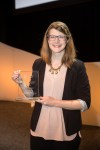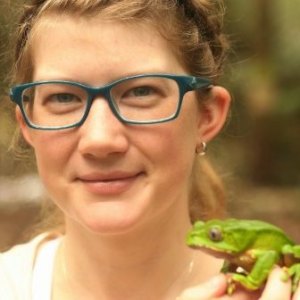
Emily Graslie is Chief Curiosity Correspondent for The Field Museum in Chicago, and the host, creator, and writer for its educational YouTube series, The Brain Scoop @ehmee

Around this time last year I received an email from Elizabeth Merritt, Vice President, Strategic Foresight and Founding Director of the Center for the Future of Museums, notifying me that, my colleague and workshop collaborator, Chris Norris, Senior Collections Manager of the Yale Peabody Museum was nominating me for the Nancy Hanks Memorial Award for Professional Excellence. It’s an honor awarded by the American Alliance of Museums Board of Directors to a museum professional with less than ten years of experience in the field, and “recognizes an achievement or body of work that has benefited either the honoree’s home institution or the museum field in general.”
In order to complete the nomination, AAM required some information from me, like my position description and curriculum vitae, to which I sheepishly responded, “I’m honored, and simultaneously embarrassed because I don’t actually have a position description.”
In 2013 when I became the first-ever Chief Curiosity Correspondent for The Field Museum, the role came with a blank slate. My supervisor at the time wanted to keep my work open-ended to allow for fluidity, growth, quick changes and nimble redirections as needed. So, in my tenure here at the Field I’ve continued to operate in that way, all the while lacking a basic framework to help answer the question, “What does a Chief Curiosity Correspondent do, anyway?” But, AAM needed something, so I wrote up a one-pager outlining the primary functions of my work: handling the creative direction of our educational YouTube show, The Brain Scoop; participating in museum outreach activities and facilitating public dialogue about museums and science communication; and the myriad of other hats we museum people wear in spades. A few months later I was notified by the AAM Honors Committee that I was selected to be the 2017 honoree and that the award came with a $1,000 stipend to ‘support [my] further professional development. It is the greatest professional achievement of my (still early) career and one that fills me with a great deal of pride.
Skip over related stories to continue reading articleFor months I thought about the potential for that $1,000. I’d never considered what professional development for someone in my position looks like: I’m a video producer, a science communicator, a woman in new media, a museum professional, and a digital content creator. I’d have to attend at least five different professional conferences in order to tick off all of those boxes, and to be honest — as an incredibly introverted person — I’m not exactly the conference-goer type. Yikes.
And then, lo and behold, someone tweeted me a link to a non-profit program, The Coaching Fellowship, that was accepting applications for their 2017 cohorts, and suggested I apply. Every year, The Coaching Fellowship selects around 150 “young high potential women leaders” from around the world to receive executive level coaching at a massively reduced rate. It was founded in 2014 by Jane Finette, Chief of Staff to the Executive Chairwoman of Mozilla, to provide pro-bono coaching and fellowship to women at crucial points in their careers. Executive coaching isn’t exactly, ahem, affordable for those of us early career non-profit employees, and such programs or services can cost many thousands of dollars. But if accepted into The Coaching Fellowship, participants are only expected to donate a $495 fee to the program to support their operational costs, and in turn they receive 6 months of personalized, professional coaching. I applied and, a few months later, was notified of my acceptance into the Fall 2017 cohort of fellows.
I feel incredibly fortunate to have had these two opportunities for the direction they have given my work over the past few months. I was hired at the Field with little to no prior managerial training (I now manage two staff and the occasional intern), a completely open job description, and the daunting task of bringing our institution’s research and collections work to a diverse, global audience — and do so from the ground up. The Nancy Hanks award offered me the chance to seek out the leadership development I need, and – through The Coaching Fellowship – has helped me continue moving the museum field forward in the realm of digital media and science communication. Not only has my coach Eileen guided me in refining that job description (thanks, Eileen!), but she’s also been instrumental in my ability to focus on and strengthen my core values, identify areas for personal and professional growth, evaluate how I determine my own success (beyond YouTube views and analytics), and gain clarity about future program dreams and goals.
With nominations for the 2018 Nancy Hanks award now open I encourage everyone to look around for those leaders with great potential at your own institutions, or at partnering organizations. They will be the ones responsible for the future of the museum field: investing in their growth early on is a crucial step in empowering them with the tools and confidence they will require to continue moving our field forward.
The Rare Book Room!
The Field Museum isn’t just home to specimens and artifacts: it’s also home to the books and manuscripts that have shaped our understanding of the world’s natural history. Today, we look at some of the 7,500 books in the Mary W. Runnells Rare Book Room!
About The Brain Scoop
In 2013 as a volunteer for the University of Montana Zoological Museum, Emily — with the help of educator Hank Green — launched the channel with the goal of sharing the behind-the-scenes research and collections work of natural history museums with a broad audience. A few months later the program relocated to their new home in Chicago, and today, Emily and her team have created 180 educational videos that have been viewed more than 22 million times by passionate learners from all over the world.









Comments